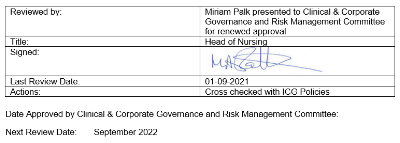VERSION: 1
DATE OF IMPLEMENTATION/REVIEW: 01/09/2021
IMPLEMENTED AND AUDITED BY: Alex Hashash
STATUS: Approved
COMMENTS: To be reviewed 01/09/2022
Purpose
This policy statement has two main purposes:
Note. Where five or more persons are employed.
Statement
The Company fully understands and accepts its obligations and responsibilities in respect of health and safety, with overall responsibility being assigned to (Insert Job Title). The Company’s obligations are summarised in this policy, alongside the duties and responsibilities of employees. Our aim is to ensure that our activities are undertaken in a safe and appropriate manner at all times.
Procedure and Guidance
The responsibilities of the Company:
Equipment used
The Company will ensure that all plant and equipment is regularly inspected and maintained, in accordance with a maintenance schedule. All repairs will be carried out at the earliest opportunity. If any plant or equipment is judged to be damaged or unsuitable for use for any reason it will be put out of action, with clear signage.
Safe premises and place of work
The Company will ensure that the premises are safe, and that all hazards are removed where possible. If it is not possible to remove a hazard clear signage will be displayed advising employees and any other visitors to the premises of the nature of the hazard and the precautions that should be taken.
Competent and safe fellow employees
The Company will ensure that all employees receive the appropriate training so that they are competent in all their work duties. If any employee acts in a manner that is likely to put others in danger, then appropriate disciplinary action will be taken.
A safe system of work
The Company will ensure that all processes of work are safe. If there are any hazards the Company will endeavour to remove them.
If that is not possible appropriate signage will be displayed advising employees and any other visitors to the premises of the nature of the hazard and the precautions that should be taken.
The responsibilities of the employee
The employee is responsible for ensuring that his/her actions do not cause danger to themselves or to anyone else. The primary responsibilities of the employee include the following.
Not to tamper with any equipment
Employees should not carry out any alterations to equipment which might compromise health and safety. Employees who do tamper with equipment are likely to face disciplinary action, which could include summary dismissal.
Not to use any equipment without receiving appropriate training
No employee should use any equipment without having the appropriate training. The employee is responsible for attending any training that is arranged and completing any assessments that are required.
To take reasonable care of their own health and safety
Employees are expected to act responsibly and to take care of their own health and safety. This includes wearing any necessary protective clothing and not acting in a dangerous manner. All employees must take care that their actions do not endanger any other employees or visitors to the company.
To use equipment appropriately
Employees should use equipment for the purpose for which it is provided, and no other purpose. If any equipment is damaged or unfit for purpose in any way the employee is required to inform the Company immediately.
To follow appropriate systems of work
All employees should follow the systems of work that have been specified by the Company. There should be no deviation from these systems without prior permission from the Company.
Personal protective equipment (PPE)
The Company is responsible for supplying employees with any personal protective equipment (PPE) that is required. If an employee does not have the appropriate PPE for a specific task, then the employee should inform the Company immediately and not perform that task until the PPE is available. The employee is responsible for taking care of the PPE that has been issued. If any PPE is damaged the Company should be informed immediately. An employee is required to return all PPE that has been issued on leaving the organisation.
Chemicals and other substances
All chemicals and other substances that are hazardous to health must be stored and used in accordance with the manufacturers’ instructions. Such materials will have a COSHH (Control of Substances Hazardous to Health Regulations 2002) label on them, and the guidance on this label must be followed in full.
Risk assessments
All line managers are required to carry out regular risk assessments of the area and activities under their management. These risk assessments should be carried out annually at least, and some risk assessments will require more regular completion.
The risk assessments should be recorded in writing, with an agreed target date for any actions that have been identified. If there are any risks that cannot be eliminated all employees working in that area must be made aware.
Manual handling
All employees who are involved in any lifting or carrying must have received training in relation to manual handling. This training must be renewed every two years. The line manager is responsible for ensuring that all employees requiring this training attend the training course at the appropriate time.
Accidents
Although every effort will be made to ensure a safe environment it is accepted that accidents can occur. If an accident does occur this must be reported immediately to. It must also be recorded in the accident book.
If any of the following occur, they must be reported to the Health and Safety Executive under the RIDDOR procedures (see www.riddor.gov.uk):
In addition, some work-related diseases and dangerous occurrences must be reported to the Health and Safety Executive. Following any accident, the situation will be investigated to determine whether changes need to be made to equipment, training or systems to work so that a similar situation can be prevented in the future.
KLOE Reference for this Policy: Safe
Regulations directly linked to this Policy: Regulation 12: Safe care and treatment
Regulation(s) relevant to this Policy:
Next Review
